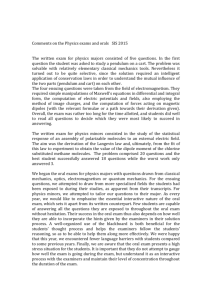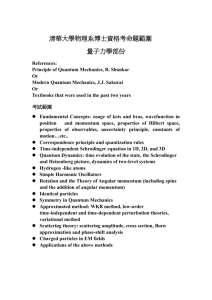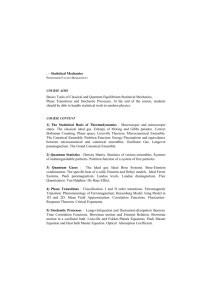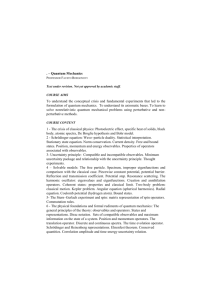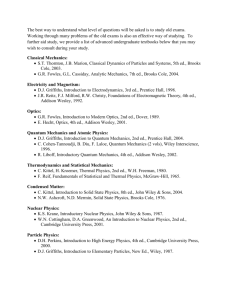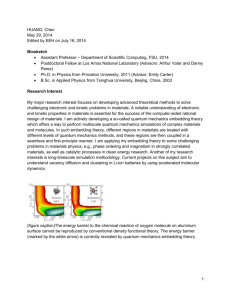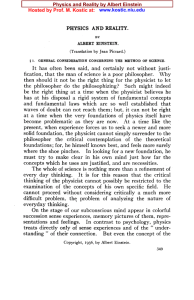MOTION (source: www.wikipedia.org, Kelly, Kurt: Science) Read the
advertisement
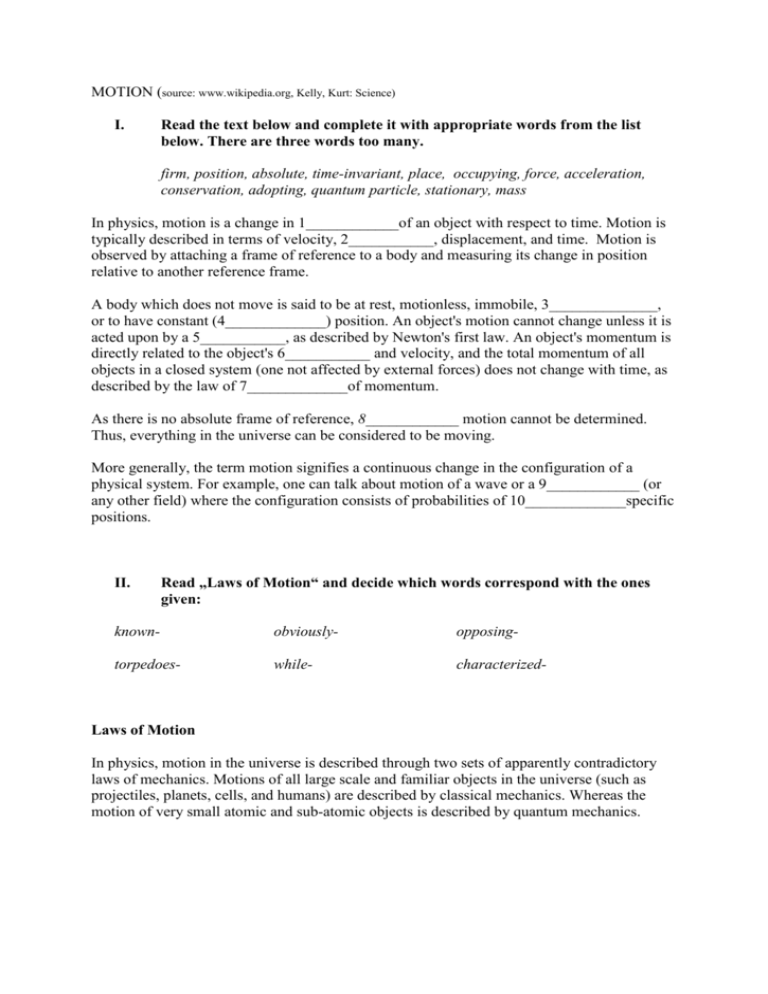
MOTION (source: www.wikipedia.org, Kelly, Kurt: Science) I. Read the text below and complete it with appropriate words from the list below. There are three words too many. firm, position, absolute, time-invariant, place, occupying, force, acceleration, conservation, adopting, quantum particle, stationary, mass In physics, motion is a change in 1____________of an object with respect to time. Motion is typically described in terms of velocity, 2___________, displacement, and time. Motion is observed by attaching a frame of reference to a body and measuring its change in position relative to another reference frame. A body which does not move is said to be at rest, motionless, immobile, 3______________, or to have constant (4_____________) position. An object's motion cannot change unless it is acted upon by a 5___________, as described by Newton's first law. An object's momentum is directly related to the object's 6___________ and velocity, and the total momentum of all objects in a closed system (one not affected by external forces) does not change with time, as described by the law of 7_____________of momentum. As there is no absolute frame of reference, 8____________ motion cannot be determined. Thus, everything in the universe can be considered to be moving. More generally, the term motion signifies a continuous change in the configuration of a physical system. For example, one can talk about motion of a wave or a 9____________ (or any other field) where the configuration consists of probabilities of 10_____________specific positions. II. Read „Laws of Motion“ and decide which words correspond with the ones given: known- obviously- opposing- torpedoes- while- characterized- Laws of Motion In physics, motion in the universe is described through two sets of apparently contradictory laws of mechanics. Motions of all large scale and familiar objects in the universe (such as projectiles, planets, cells, and humans) are described by classical mechanics. Whereas the motion of very small atomic and sub-atomic objects is described by quantum mechanics. III. Read the text on classical mechanics and decide where to put the phrases from under the text Classical mechanics Classical mechanics is used for describing the motion of macroscopic objects, from projectiles to parts of machinery, as well as astronomical objects, 1_________________________ and galaxies. It produces very accurate results within these domains, and is one of the oldest and largest subjects in science, engineering, and technology. Classical mechanics is fundamentally based on Newton's Laws of Motion. 2____________________________They were first compiled by Sir Isaac Newton in his work Philosophiæ Naturalis Principia Mathematica, first published on July 5, 1687. His three laws are: 1. In the absence of a net external force, a body either is at rest or moves with constant velocity. 2. The net external force on a body is equal to the mass of that body times its acceleration; F = ma. Alternatively, the acceleration is directly proportional to the force causing it, 3______________________________ 3. Whenever one body exerts a force F onto a second body, the second body exerts the force −F on the first body. F and −F are equal in magnitude 4______________________ Newton's three laws of motion, 5________________________ , explain Kepler's laws of planetary motion, which were the first to accurately provide a mathematical model or understanding orbiting bodies in outer space. This explanation unified the motion of celestial bodies and motion of objects on earth. Classical mechanics was later further enhanced by Albert Einstein's special relativity and general relativity. Special relativity explains the motion of objects with a high velocity, 6__________________________; general relativity is employed to handle gravitation motion at a deeper level. These laws describe the relationship between the forces acting on a body and the motion of that body. and inversely proportional to the mass. such as spacecraft, planets, stars, approaching the speed of light along with his law of universal gravitation and opposite in sense. IV. Read the text below and look for mistakes (there is maximum one mistake in each line, some lines may be without mistakes at all. If so, put a tick next to the line) Quantum mechanics Quantum mechanics is a set of principles in describing physical reality at the atomic level of matter (molecules and atoms) and the subatomic (electrons, protons, and even smaller particles). These descriptions include for the simultaneous wave-like and particle-like behaviour of both matter and radiation energy, this described in the wave–particle duality. In contrast to classical mechanics, where accurate measurements and predictions can be calculated about location and velocity, in the quantum mechanics of a subatomic particle, one can never specify its state, such as its simultaneous location and velocity, with completed certainty (this is called the Heisenberg uncertainty principle). In addition to describing the motion of atomic level phenomenas, quantum mechanics is useful in understanding some large scale phenomenon such as superfluidity, superconductivity, and biological systems, including the function of smell receptors and the structures of proteins. V. Listen to the recording and complete the text with words or phrases you can hear A football, rolling along the ground, slows down and stops. Freewheeling along a level road on your bicycle, you slow down and stop. Both the football and the bicycle have 1__________________ or slowed down and so a force must have acted on them. The force that opposes motion is called 2___________________. It is caused by the roughness of the surface. Even a surface that looks smooth will have tiny 3______________________ that cause it. There are two types of this kind of forces. 4____________________ is the force that prevents a stationary object from moving. 5____________________ acts to slow a moving object. The amount of both depends on factors like 6____________________. The nature of the surface, whether it is smooth or rough is also important. Smooth and streamlined objects will produce 7_____________________. However, the speed of an object is also important: the faster it moves, the greater its 8_____________________. VI. Match the beginnings of the sentences below with their endings
